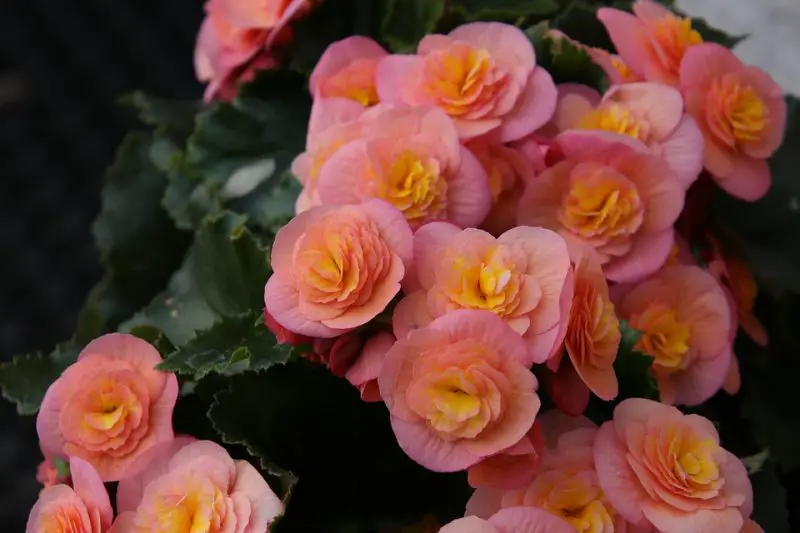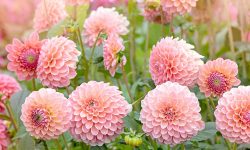Begonias are among the most beloved flowering plants, prized for their lush foliage, vibrant blooms, and adaptability to both indoor and outdoor environments. However, one of the most critical factors influencing their health and appearance is watering. Knowing how often to water begonias can make the difference between a thriving plant and one that struggles to survive. Overwatering can lead to root rot, while underwatering can result in wilted leaves and poor flowering.
In this comprehensive guide, you’ll discover everything you need to know about how often to water begonias for lush growth and vibrant blooms. From understanding the different types of begonias to considering environmental factors, soil quality, and seasonal changes, this article will equip you with the knowledge to keep your begonias flourishing all year long.
Understanding the Different Types of Begonias

Tuberous Begonias
Tuberous begonias thrive in partial shade and cooler temperatures, making them ideal for shaded patios, hanging baskets, and north-facing garden beds. They produce large, rose-like flowers in a variety of vibrant colors such as red, orange, pink, and white. Their fleshy underground tubers store energy, allowing the plant to go dormant during winter. During the growing season—from late spring to early fall—these begonias need consistently moist but not soggy soil. It’s essential to let the topsoil dry slightly before the next watering to prevent tuber rot. As the blooming season ends, reduce watering gradually to encourage dormancy. After the foliage dies back, lift and store the tubers in a cool, dry place for the winter months.
Fibrous-Rooted Begonias
Fibrous-rooted begonias, including popular varieties like wax begonias and dragon wing begonias, are prized for their durability and ease of care. They feature a dense network of fine roots that readily absorb moisture and nutrients from the soil. These begonias bloom profusely throughout the growing season and are particularly well-suited to bedding displays, window boxes, and container gardens. While they tolerate a wider range of conditions compared to other types, consistent watering is still essential to support continuous flower production and healthy foliage. Allowing the top inch of soil to dry out between waterings helps prevent overwatering. These plants also benefit from morning watering to minimize the risk of fungal diseases.
Rhizomatous Begonias
Rhizomatous begonias are best known for their stunning foliage, which can range from velvety textures to spiraled patterns and multicolored leaves. They grow horizontally from thickened, creeping stems called rhizomes that rest on or just below the soil surface. These begonias are primarily grown indoors, where environmental conditions can be controlled more easily. Because the rhizomes are prone to rot, the soil must be well-draining and never allowed to remain soggy. Watering should be done when the top layer of soil feels dry to the touch, and it’s crucial to water at the base rather than overhead. In high-humidity environments, these begonias thrive and show lush growth, but in drier settings, consider using humidity trays or pebble trays to maintain optimal conditions without overwatering. Regular attention to moisture levels and good air circulation are key to keeping rhizomatous begonias healthy and thriving.
Why Watering Matters for Begonia Health
Watering plays a vital role in begonia health by supporting essential functions like nutrient absorption, photosynthesis, and overall plant growth. With consistent and proper moisture, begonias develop strong roots, lush foliage, and vibrant blooms. Well-hydrated plants are also more resilient to stress, pests, and temperature changes.
However, improper watering is a common cause of problems. Overwatering leads to soggy soil, which can suffocate roots and cause rot, while underwatering results in wilting, dry leaves, and poor flowering. The key is maintaining evenly moist but not saturated soil, allowing the top layer to dry slightly between waterings.
Good watering habits also help prevent fungal issues, especially when done in the morning so foliage can dry quickly. By mastering when and how to water, you create the ideal conditions for your begonias to thrive, whether they are grown indoors or outdoors.
Factors That Affect How Often to Water Begonias
Type of Begonia
Each type of begonia has a unique root structure and growth pattern that affects its water needs. Tuberous begonias, with their fleshy underground tubers, store water and nutrients but are susceptible to rot if overwatered, especially in cool weather. They need consistent moisture during active growth but should be allowed to dry slightly between waterings. Fibrous-rooted begonias have fine, moisture-absorbing roots and generally require more frequent watering, especially during hot or dry periods. Rhizomatous begonias store water in their thick stems and are more sensitive to excess moisture, so it’s essential to water only when the topsoil begins to dry.
Indoor vs. Outdoor Conditions
Indoor begonias benefit from a stable environment with regulated temperature and humidity. As a result, they often require less frequent watering compared to outdoor plants. However, indoor air conditioning or heating can dry the soil faster than expected, so checking moisture levels is still important. Outdoor begonias are subject to changing weather conditions, including intense sun, wind, or rain. Full sun exposure or strong breezes can dry out the soil quickly, especially in containers, making daily checks during warm months essential for preventing dehydration.
Potting Container and Drainage
The material and design of your container can dramatically impact watering frequency. Porous materials like terracotta allow water to evaporate more quickly, which is helpful in humid climates but can require more frequent watering in dry areas. Plastic or glazed ceramic pots retain moisture longer. Containers without drainage holes trap excess water, creating a high risk of root rot. Always use pots with proper drainage, and consider adding a layer of gravel or using a well-draining potting mix to help prevent water from pooling at the bottom.
Soil Type and Composition
The soil your begonia is planted in must strike a balance between retaining moisture and draining excess water. Light, airy potting mixes enriched with peat moss, coco coir, or compost help retain moisture without waterlogging the roots. Adding materials like perlite or pumice improves aeration and drainage, ensuring the roots get enough oxygen. Avoid heavy soils like pure garden loam or clay, which can become compacted and hold too much water, leading to rot and fungal issues.
Temperature and Humidity
Environmental conditions play a key role in how quickly soil dries out. High temperatures accelerate evaporation and increase plant transpiration, which means begonias will need more frequent watering. In contrast, cooler or overcast conditions slow down these processes. Humidity also affects water needs—begonias growing in dry indoor air or arid climates require more frequent watering or humidity-boosting techniques, such as using trays with pebbles and water or grouping plants together. In naturally humid regions, soil may stay moist longer, so watering must be adjusted to avoid excess moisture.
Season and Growth Stage
Begonias have different water needs depending on the time of year and their stage of development. During spring and summer, active growth and flowering demand more consistent moisture to support photosynthesis and flower production. As fall approaches, most begonias begin to slow down, and watering should be reduced accordingly. In winter, particularly for tuberous begonias that go dormant, the soil should be kept barely moist or allowed to dry almost completely. Overwatering during dormancy is one of the most common causes of tuber rot and decline.
How to Determine When to Water Begonias
The Finger Test
The finger test is a simple and effective way to assess soil moisture without needing any tools. Gently insert your index finger into the soil up to the first knuckle—about one inch deep—for smaller pots, or up to the second knuckle for larger containers or garden beds. If the soil feels dry at that depth, it’s usually time to water. If it still feels cool and moist, wait another day before checking again. This method works well for both indoor and outdoor begonias and helps prevent overwatering by ensuring the roots aren’t sitting in wet soil. It’s especially useful for beginners or when you’re adjusting to seasonal changes.
Soil Moisture Meters
Soil moisture meters are a reliable tool for gardeners who want precision and consistency in their watering routine. These devices use a metal probe inserted into the soil to measure moisture levels at the root zone. Most meters have a scale that ranges from dry to wet, giving you a clear indication of whether your begonia needs watering. They’re particularly helpful when dealing with larger pots, deep containers, or hard-to-read outdoor conditions where the finger test might not be practical. Using a moisture meter can also be useful if you’re caring for multiple begonias in different locations with varying light and temperature, allowing you to tailor watering to each plant’s specific needs.
Observing Plant Appearance
Begonias often give visual clues when their watering needs are not being met. When a begonia is underwatered, you may notice the leaves drooping, curling, or turning dry and brittle at the edges. Flower production may slow, and buds might drop before opening. In contrast, signs of overwatering include yellowing or translucent leaves, mushy stems, and a sour or musty smell from the soil—indicators of rot setting in. If the plant looks limp but the soil is still wet, root damage may already be occurring. Observing your plant regularly and noting subtle changes in appearance will help you spot problems early and make timely adjustments to your watering routine.
Watering Guidelines for Different Environments
Indoor Begonias
Indoor begonias enjoy the advantages of a stable temperature and protection from harsh weather, but they are not immune to watering issues. Since indoor air can become dry due to heating or air conditioning, soil may dry out faster than expected, especially in winter. Water the plant when the top inch of soil feels dry, and always check the bottom of the pot to ensure it’s not retaining excess moisture. Placing the pot on a saucer filled with pebbles and water can help raise humidity around the plant without soaking the roots. Good air circulation is also essential indoors to prevent mold and mildew, especially if the plant is in a humid room like a bathroom or kitchen.
Outdoor Begonias
Outdoor begonias are more exposed to the elements, and their watering needs fluctuate with the weather. During hot spells, especially in full sun or windy conditions, begonias in the ground may need watering every day or every other day to maintain consistent soil moisture. In shady or partially shaded areas, watering can be less frequent. The best time to water is early in the morning, giving the plant time to absorb moisture before the heat of the day and allowing foliage to dry by evening, which helps prevent fungal infections. Mulching around the base can also help conserve soil moisture and reduce how often you need to water.
Container-Grown Begonias
Begonias grown in containers dry out more quickly than those planted in garden beds due to limited soil volume and greater exposure to air. This is especially true for pots placed on balconies, patios, or windowsills where they receive direct sunlight or wind. To keep them hydrated, check the soil daily—sometimes even twice a day in extreme heat. Use a well-draining potting mix and containers with drainage holes to prevent water from pooling at the bottom. During very hot weather, you might need to water more than once a day. Grouping containers together can help reduce evaporation, and placing them in partial shade during peak sun hours will help minimize water stress.
Seasonal Watering Tips for Begonias
Spring
As temperatures rise and daylight increases, begonias awaken from their winter dormancy. Begin watering lightly when you see signs of new shoots or leaves emerging. At this stage, the roots are delicate and still developing, so it’s important not to saturate the soil. Instead, aim for a light, even moisture that encourages steady growth. Using a well-draining potting mix or refreshing the top layer of soil can also improve early-season hydration.
Summer
This is the most active growing season for begonias, and they require consistent moisture to support lush foliage and vibrant blooms. Water thoroughly when the top inch of soil feels dry, ensuring the water reaches the root zone. Outdoor begonias may need daily watering during hot spells, especially if they’re in containers or hanging baskets that dry out quickly. Adding mulch around garden begonias helps reduce evaporation, regulate soil temperature, and minimize watering frequency.
Fall
As temperatures begin to cool and the days shorten, begonias naturally slow their growth. Begin reducing the frequency of watering, allowing the top layer of soil to dry more between each session. For tuberous begonias, this is the beginning of dormancy. Gradually reduce water to encourage the foliage to yellow and die back. This process signals the plant to conserve energy and prepare for winter rest. Remove any fallen leaves to prevent fungal issues as the weather becomes damp.
Winter
Winter care depends on the begonia type. Tuberous begonias should be completely dry during dormancy. Once the foliage dies back, stop watering and store the tubers in a breathable bag or box filled with peat moss or sawdust in a cool, dark location. For indoor varieties like rex or wax begonias, growth may continue slowly. Water only when the top 1–2 inches of soil are dry, and avoid misting or overwatering, as lower winter light levels and cooler indoor temperatures make root rot more likely.
Common Watering Mistakes to Avoid
Overwatering
Overwatering is the most frequent mistake made by begonia growers. While these plants appreciate consistent moisture, soggy or waterlogged soil can suffocate the roots and promote rot-causing fungi like Pythium or Rhizoctonia. This often happens when pots lack drainage holes or when watering is done on a strict schedule rather than in response to actual soil conditions. Signs of overwatering include yellowing leaves, soft stems, and a foul smell from the soil. To prevent this, always allow the top inch of soil to dry out slightly between waterings and choose well-draining potting mixes.
Underwatering
On the flip side, underwatering can severely stress your begonia. When the soil becomes too dry, the plant struggles to absorb nutrients, resulting in wilting, browning leaf edges, reduced flowering, and leaf drop. This issue is especially common in hot or dry climates, or when begonias are grown in small pots that dry out quickly. Check the soil regularly, especially during summer, and don’t wait for the plant to show distress before watering.
Watering the Foliage
Watering over the leaves instead of directly at the base can lead to serious problems. Moist foliage creates an ideal environment for powdery mildew, botrytis (gray mold), and other fungal diseases. This is particularly risky if you water late in the day or in humid conditions when moisture lingers overnight. Always aim to water at soil level using a spout or watering can with a narrow neck, keeping the leaves dry and disease-free.
Using Cold Water
Cold tap water, especially in winter, can shock the roots and slow down growth. Begonias prefer water that’s close to room temperature, as it’s gentler on their root systems. If your water supply is very cold, allow it to sit out indoors for a few hours before watering. This small adjustment can help prevent stress and promote healthier root activity.
Watering on a Rigid Schedule
Watering on a fixed schedule without checking soil conditions can easily lead to either overwatering or underwatering. Begonias’ needs vary depending on temperature, humidity, light exposure, and growth stage. Instead of sticking to a calendar-based routine, feel the soil with your fingers. If the top inch feels dry, it’s usually time to water. Adapting your routine to your plant’s actual needs will help it thrive year-round.
How to Adjust Watering When Repotting or Transplanting
When repotting or transplanting begonias, adjusting your watering routine is essential to help the plant recover from stress and adapt to its new environment. Right after transplanting, water the plant thoroughly to help settle the soil around the roots and eliminate air pockets. This initial watering should be deep but gentle to avoid compacting the fresh soil mix.
In the days following transplanting, avoid overwatering. The roots are more sensitive during this period and need time to adjust. Instead of sticking to a routine schedule, monitor the soil’s moisture level closely. Water only when the top inch of soil feels dry to the touch. In most cases, newly potted begonias require less frequent watering than established ones, especially if the new container retains moisture well.
Ensure the new pot or planting site has excellent drainage to prevent water from accumulating around the roots. If you’re using fresh potting mix with added moisture-retaining materials like peat or coco coir, be cautious not to overdo watering, as these mixes can hold water longer.
Additionally, reduce humidity stress by placing the plant in a shaded, sheltered location for a few days after transplanting. This gives the plant a chance to acclimate without the added burden of direct sunlight, which can increase water loss through evaporation. Once you see new growth or the plant looks perkier, resume a more regular watering schedule tailored to its growing conditions.
Special Considerations for Different Climates
Dry and Arid Climates
In hot, dry climates, begonias can dry out very quickly, especially when grown in containers or hanging baskets. Watering may be required daily during peak summer months. Use pots made of non-porous materials like plastic or glazed ceramic to retain moisture better. Mulching the soil surface helps reduce evaporation and maintain a cooler root environment. For indoor begonias, cluster them together to create a mini-humid microclimate, and consider placing water-filled trays with pebbles nearby to boost ambient humidity without overwatering the roots.
Humid Climates
In naturally humid environments, begonia watering must be carefully balanced to avoid over-saturation. While the air may provide ample moisture for foliage, roots can suffer from excess water retention if the soil doesn’t drain well. Always use a loose, airy potting mix and containers with ample drainage holes. Empty saucers and trays promptly after watering to prevent root rot. Good airflow is vital—position begonias where they can receive light breezes or use a fan indoors to help evaporate excess moisture and minimize the risk of fungal leaf spots and mildew.
Cold Climates
Begonias grown in cold climates typically require less frequent watering, particularly in winter when plant growth slows dramatically. If your begonia is overwintering indoors, let the top inch or two of soil dry out completely before watering again. Reduce watering to once every 10–14 days or as needed based on indoor humidity and temperature. If begonias are grown outdoors during the growing season, water normally during summer but start tapering off in early fall to help the plant prepare for dormancy. Avoid watering late in the day to prevent water from sitting on the leaves or in the crown overnight in cold temperatures.
How to Set a Watering Schedule That Works
Track Your Watering
Keeping a consistent log of your watering routine can make a significant difference in your begonia’s health. Use a notebook, gardening app, or even a simple calendar to record dates, amounts, and any observations like leaf droop or soil dryness. Over time, this log will help you identify the ideal frequency for your specific environment and allow you to catch any developing issues before they affect the plant’s health. This is especially helpful if you’re caring for multiple begonias or adjusting to seasonal changes.
Create a Routine, But Stay Flexible
A regular watering schedule can promote stability in your begonia’s environment, but it’s essential to remain responsive to changing conditions. For example, during hot summer months, your plant may require more frequent watering, while cooler or more humid periods may call for less. Don’t rely solely on the calendar—check the soil with your finger or a moisture meter before watering. Flexibility is key: the goal is to meet your plant’s actual needs, not stick rigidly to a preset schedule.
Combine with Fertilizing
Watering and fertilizing go hand in hand when caring for begonias. Always water your begonia thoroughly before applying fertilizer to prevent root burn, especially when using concentrated or chemical-based products. A diluted liquid fertilizer applied every 2–4 weeks during the active growing season can help boost flower production and encourage lush foliage. Integrating fertilizing into your watering schedule ensures your plant receives both hydration and nutrients in a balanced way, making it easier to maintain consistent care.
FAQ About How Often to Water Begonias
How often should I water my begonias?
The frequency depends on the type of begonia, the potting medium, and your local climate. As a general rule, water when the top inch of soil feels dry. In warm, dry weather, you might need to water every 2–3 days, while in cooler or more humid conditions, once a week may be enough. Always check the soil before watering to avoid overwatering.
What are the signs of overwatering in begonias?
Signs include yellowing leaves, a mushy or foul-smelling base, and mold or fungus on the soil surface. If roots are consistently wet, they may rot, eventually killing the plant. Always make sure your begonia pot has proper drainage and allow the soil to dry slightly between waterings.
Can I mist my begonias to increase humidity?
Yes, but with caution. While begonias enjoy humidity, misting directly on the leaves can encourage powdery mildew or leaf spots. Instead, place a humidity tray nearby, group plants together, or use a humidifier to safely raise humidity levels without risking foliar diseases.
Is tap water safe for watering begonias?
It depends on the quality of your tap water. If it’s high in salts, chlorine, or fluoride, it may cause brown leaf tips or long-term root damage. Using rainwater, distilled water, or filtered tap water is often safer, especially for sensitive varieties like Rex begonias.
Should I water begonias differently during winter?
Yes. Begonias slow down their growth in winter and require less water. Cut back on watering frequency and always ensure the soil is dry to the touch before watering again. Overwatering during dormancy is one of the most common causes of winter begonia decline.
Conclusion
Learning how often to water begonias for lush growth and vibrant blooms requires observation, adjustment, and a little patience. There’s no one-size-fits-all answer, but by considering the type of begonia, growing environment, soil conditions, and seasonal changes, you can develop a watering routine that keeps your plants healthy and thriving.
By avoiding common mistakes like overwatering and recognizing the signs of moisture stress, you’ll give your begonias the best chance to reward you with a spectacular display of foliage and flowers. Whether you’re growing begonias in pots, garden beds, or as indoor houseplants, mastering the art of watering is key to their long-term success and beauty.






